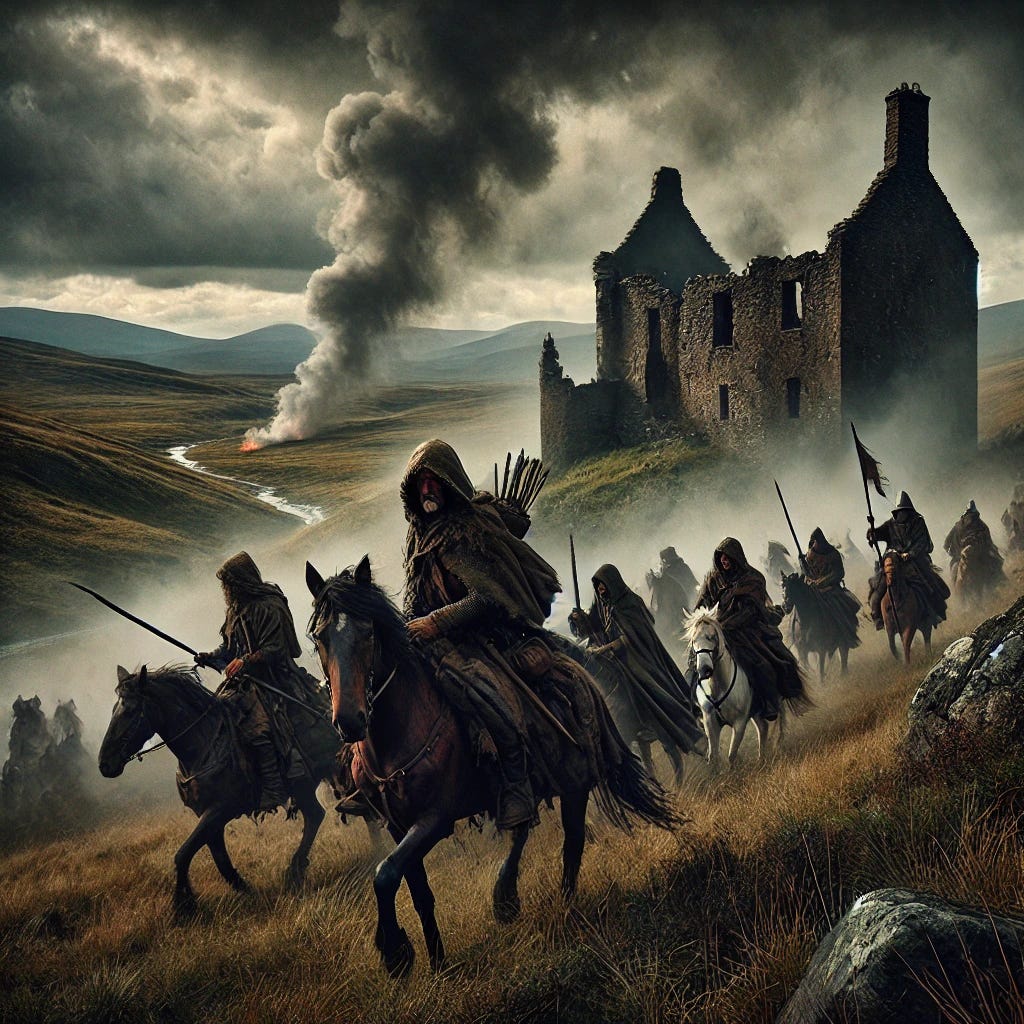Why the Scottish Borders Were the Most Lawless Lands in Britain
A Land Between Kingdoms, A Law Unto Itself
For centuries, the Scottish Borders — that rugged, wind-bitten stretch between England and Scotland — were less a frontier and more a feral battleground. Caught in the political tug-of-war between two kingdoms, the Borderlands bred a unique society that answered to neither crown completely. Here, the rule of law was often replaced by the law of the sword. If you lived between the Rivers Tweed and Solway in the 13th to 17th centuries, you learned quickly: survival depended more on loyalty to your kin than to any king.
But why exactly were the Borders such a chaos zone for so long?
The answer lies in the tangled roots of war, geography, tribalism — and an economy built almost entirely on theft.
The Devil's Playground: War, Revenge, Repeat
The animosity between England and Scotland didn’t begin in the Borders — but it flourished there. When Edward I of England (a.k.a. "Hammer of the Scots") tried to annex Scotland in the late 13th century, he sowed the seeds of generations of blood-feuds.
From that point on, the frontier was never truly quiet. The Wars of Scottish Independence (1296–1357) were followed by a relentless cycle of border raids, retaliations, and small-scale wars — all of which were normalized in everyday life. Major families like the Douglases, Percys, Maxwells, Kerrs, and Scotts became power players — not through diplomacy, but through cold steel and swift horses.
Each family had allies and enemies across the border. Raids (called reiving) weren’t random crimes; they were military tactics, economic survival, and revenge all rolled into one. The land became a blur of shifting loyalties, bitter grudges, and backdoor alliances that made organized law enforcement almost impossible.
No-Man’s Land: Where Crown Laws Stopped
The Borders were divided into six administrative zones known as the "Marches" — East, Middle, and West, both English and Scottish. Each was governed by a Warden, a crown-appointed official meant to control the chaos.
It didn’t work.
Wardens were often local lords with family ties to the very reivers they were supposed to police. Many played both sides. Others turned a blind eye, focusing only on raids that impacted their own wealth or status. Border justice was swift, brutal, and deeply biased.
On paper, England and Scotland agreed to hold periodic “Truce Days,” where grievances would be aired and punishments settled. In practice? These gatherings often ended in bloodshed, betrayal, or an ambush on the road home.
Even the concept of “justice” was laughably local. If your cattle were stolen, you might assemble a small army of kin and chase the thieves across the hills, burning their homes for good measure. And if someone did that to your kin? Well, you'd get your revenge next moon. The cycle continued.
The Reivers: Thieves, Heroes, Survivors
To understand Border lawlessness, you need to understand the Border Reivers — the notorious raiders who ruled the hills from the 13th through 17th centuries. These men (and often women) were warriors, rustlers, smugglers, and sometimes even respected local leaders.
Clans like the Armstrongs, Elliots, and Grahams ran operations that spanned dozens of miles, stealing cattle, extorting merchants, kidnapping for ransom, and wreaking havoc on any enemy families they could find. But reiving wasn’t just a lifestyle — it was an economy.
The land was poor. Harvests failed often. Taxation was unpredictable, and formal trade routes were dangerous. So raiding became the main source of income for many. And in a twisted way, reiving was admired — an act of cunning, bravery, and martial skill.
Some reivers were so feared and famous they became folk heroes. Others were executed publicly — only for their families to seek vengeance before the body turned cold.
And forget “justice” in the traditional sense. The reivers had their own code — kin loyalty above all. Betrayal of a blood relative was the only unforgivable sin.
End of the Wild West: Pacification and Aftermath
It wasn’t until the Union of the Crowns in 1603 — when James VI of Scotland became James I of England — that serious attempts were made to end Border lawlessness.
And James meant business.
With no more need for a buffer zone between two rival kingdoms, James cracked down hard on the Border clans. Many prominent reivers were arrested, executed, or exiled. The iron “cuckstool” of law was finally pressed down with brutal weight.
The region was renamed “The Middle Shires,” and harsh measures were taken: castles were razed, horses confiscated, weapons banned, and even entire families deported to Ireland in the Plantation schemes. Over a few decades, a culture forged in blood and ash was dismantled, though not entirely forgotten.
The Borderlands never again reached the same levels of lawless intensity. But the legends remained — in folk ballads, ruined peels, and stories passed down by firelight.
Conclusion
The Scottish Borders were lawless not by accident, but by design. They were a pressure point between two powerful nations, a stage for blood feuds and legendary raids, and a crucible in which loyalty, identity, and violence were inseparable.
To this day, you can walk the moors and stumble across a crumbling bastle-house, its stone walls blackened by old fires. You can hear the echoes in names like Armstrong or Graham — descendants of those who once ruled the land by horse and sword.
It wasn’t a peaceful place. But it was never boring.





